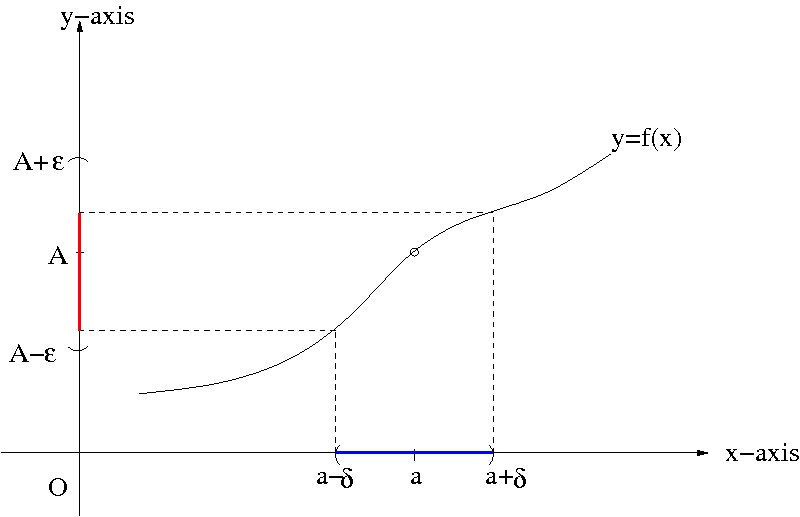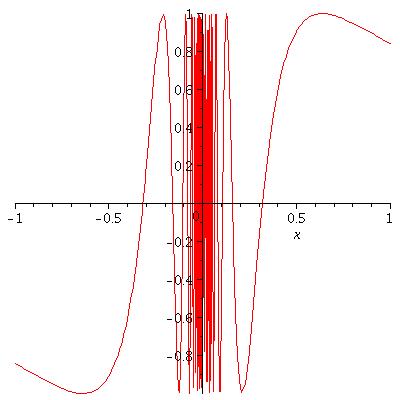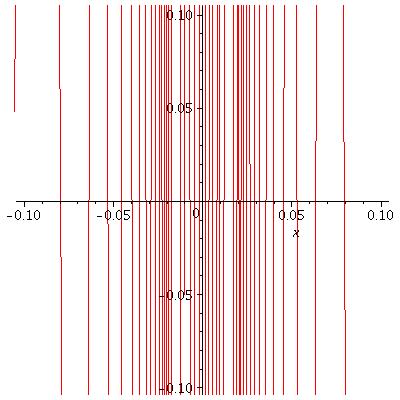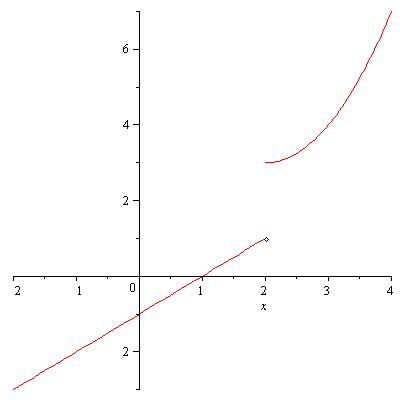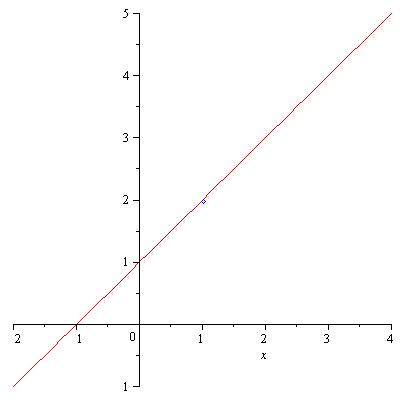When you calculate limits, the following theorem plays a crucial role.
Theorem 1. Suppose that \(c\) is a constant and the limits \[\lim_{x\to a}f(x)\ {\rm and}\ \lim_{x\to a}g(x)\] exist. Then the following properties hold:
- \(\displaystyle\lim_{x\to a}\{f(x)+g(x)\}=\lim_{x\to a}f(x)+\lim_{x\to a}g(x)\)
- \(\displaystyle\lim_{x\to a}cf(x)=c\lim_{x\to a}f(x)\)
- \(\displaystyle\lim_{x\to a}f(x)g(x)=\lim_{x\to a}f(x)\cdot\lim_{x\to a}g(x)\)
- \(\displaystyle\lim_{x\to a}\frac{f(x)}{g(x)}=\frac{\displaystyle\lim_{x\to a}f(x)}{\displaystyle\lim_{x\to a}g(x)}\) provided \(\displaystyle\lim_{x\to a}g(x)\ne 0\)
Before we discuss how we can calculate limits, there are very basic limits we need to know. They are: \[\lim_{x\to a}x=a\ {\rm and}\ \lim_{x\to a}c=c,\] where \(c\) is a constant. The limits are trivial from our intuition and also from their graphs. However, those who have analytical mind may want prove them. They can be proved using the Cauchy’s definition of a limit we discussed in the previous posting. Let us first prove \(\displaystyle\lim_{x\to a}x=a\).
Proof. Let \(\epsilon>0\) be given. Choose \(\delta=\epsilon\). Then for all \(x\) that satisfies the inequality \[|x-a|<\delta,\] it is true that \[|x-a|<\epsilon.\]
Now we prove \(\displaystyle\lim_{x\to a}c=c,\) where \(c\) is a constant.
Proof. Let \(\epsilon>0\) be given. Choose \(\delta>0\) to be any positive real number. Then for all \(x\) that satisfies the inequality \[|x-a|<\delta,\] we have \[|c-c|=0<\epsilon.\]
Using these two limits, we can now show the following useful theorem for calculating limits of polynomial functions.
Theorem 2. Let \(p(x)\) be a polynomial. Then for any real number \(b\), \[\lim_{x\to b}p(x)=p(b).\]
Proof. Let \(p(x)\) be a polynomial of degree \(n\). Then \(p(x)\) can be written as \[p(x)=a_nx^n+a_{n-1}x^{n-1}+\cdots+a_2x^2+a_1x+a_0,\] where \(a_n,a_{n-1},\cdots,a_2,a_1,a_0\) are constant real coefficients. Now \begin{eqnarray}\lim_{x\to b}p(x)&=&\lim_{x\to b}(a_nx^n+a_{n-1}x^{n-1}+\cdots+a_2x^2+a_1x+a_0)\\&=&\lim_{x\to b}a_nx^n+\lim_{x\to a}a_{n-1}x^{n-1}+\cdots+\lim_{x\to a}a_2x^2+\lim_{x\to a}a_1x+\lim_{x\to a}a_0,\ \mbox{by property 1}\\&=&a_n\lim_{x\to b}x^n+a_{n-1}\lim_{x\to b}x^{n-1}+\cdots+a_2\lim_{x\to b}x^2+a_1\lim_{x\to b}x+a_0,\ \mbox{by property 2 and \(\lim_{x\to b}a_0=a_0\)}\\&=&a_nb^n+a_{n-1}b^{n-1}+\cdots+a_2b^2+a_1b+a_0,\ \mbox{by \(\lim_{x\to b}x=b\) and property 3}\\&=&p(b).\end{eqnarray}
Theorem 2 also implies that any polynomial function is continuous everywhere. We will discuss the notion of continuity later.
Due to theorem 2 and property 4 of theorem 1, the following corollary about the limit of a rational function holds.
Corollary 3. [Limit of a Rational Function] Let \(p(x)\) and \(q(x)\) be two polynomials. Then for any real number \(b\), \[\lim_{x\to b}\frac{p(x)}{q(x)}=\frac{p(b)}{q(b)}\] provided \(q(b)\ne 0\).
Theorem 4. [Other Important Limits] Suppose that \(\displaystyle\lim_{x\to a}f(x)\) exists. Then the following properties hold:
- \(\displaystyle\lim_{x\to a}f(x)^n=[\displaystyle\lim_{x\to a}f(x)]^n\)
- \(\displaystyle\lim_{x\to a}\root n\of{f(x)}=\root n\of{\displaystyle\lim_{x\to a}f(x)}\)
- \(\displaystyle\lim_{x\to a}\ln f(x)=\ln[\displaystyle\lim_{x\to a}f(x)]\)
- \(\displaystyle\lim_{x\to a}\sin f(x)=\sin[\displaystyle\lim_{x\to a}f(x)]\)
- \(\displaystyle\lim_{x\to a}\cos f(x)=\cos[\displaystyle\lim_{x\to a}f(x)]\)
It is assumed that \(\displaystyle\lim_{x\to a} f(x)\) belongs to the domain of each function in each property. For example, in property 2 if \(n\) is an even integer, it is required that \(\displaystyle\lim_{x\to a} f(x)\geq 0\). The first property is a direct consequence of property 3 of theorem 1. The rest of the properties are related to the continuity of a function. This will be discussed later.

